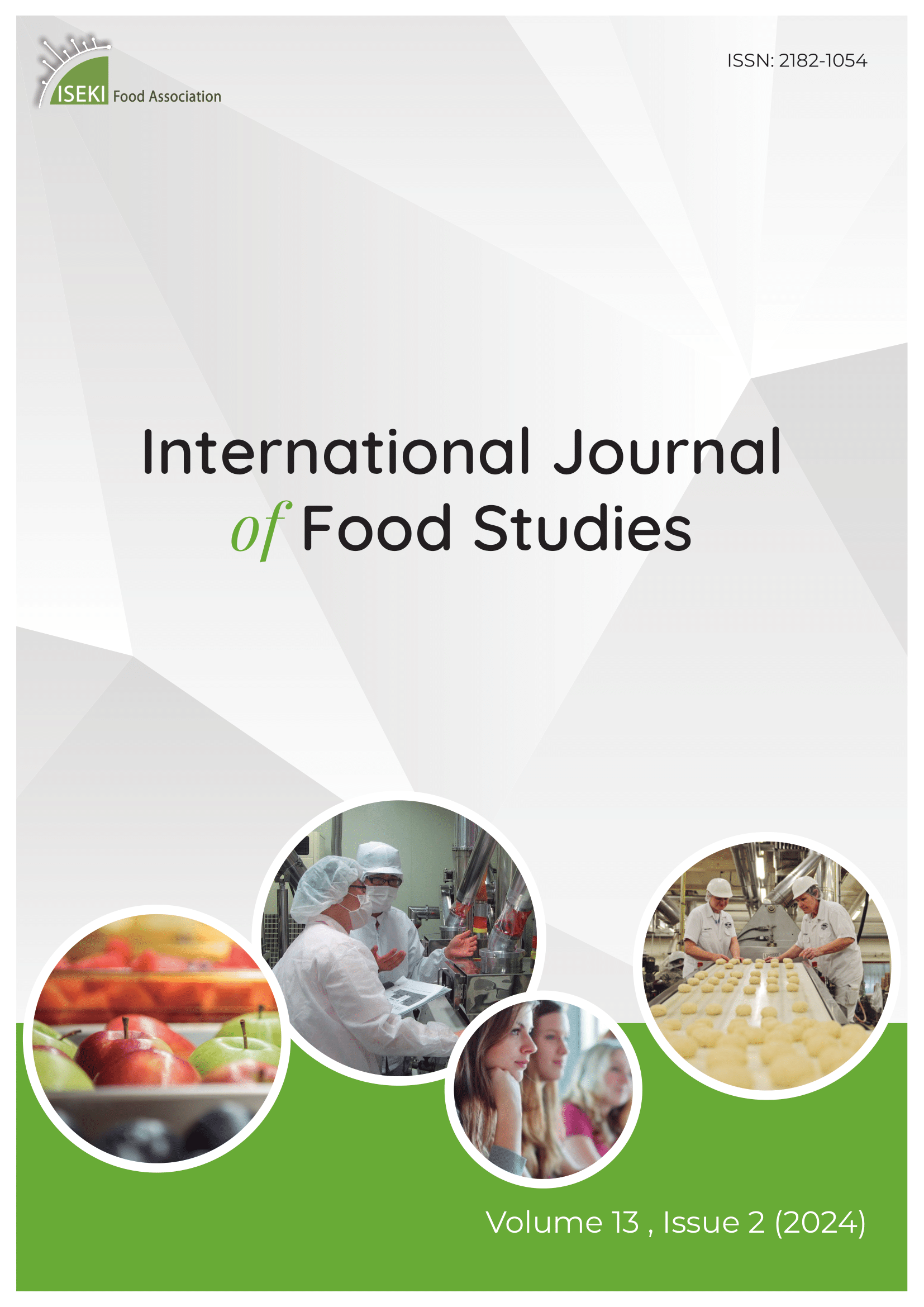Current issue

Volume 13, Issue 2, 2024
Online ISSN: 2182-1054
Volume 13 , Issue 2, (2024)
Published: 18.10.2024.
Open Access
All issues
Contents
18.10.2020.
Original scientific paper
Quality of postharvest strawberries: comparative effect of fungal chitosan gel, nanoparticles and gel enriched with edible nanoparticles coatings
This study compared, for the first time, the postharvest conservative action of edible fungal chitosan coatings (gel, nanoparticles and gel-nanoparticle) on the physico-chemical, sensorial and microbiological characteristics of strawberries. The nanoparticles were prepared by an ionic gelation method and characterized by dynamic light scattering and scanning electron microscopy. The antioxidant (DPPH* and ABTS*) activity of the edible coatings and the antimicrobial (macrodilution method) action against phytopathogenic fungi were verified. The nanoparticles had a size of 331.1 nm and a zeta potential of+ 34 mV. The gel, nanoparticles and gel+nanoparticles exhibited minimum inhibitory concentration values ranging from 4 to 5, 1.5 to 2.5 and 1.0 + 0.5 to 2.0 + 1.5 g.L-1, respectively. All the edible coatings exhibited antifungal action. All the coatings had high scavenging activity, especially the gel edible coating. The coatings, especially the gel+nanoparticles, decreased the weight loss, microbiological growth, soluble solids, maturity index and moisture loss of the strawberry and preserved the pH values, anthocyanin content, titratable acidity and sensory characteristics. Therefore, the use of chitosan edible coating containing nanoparticles can be a promising strategy to improve the post-harvest quality of strawberries.
Natália Melo, Maria Manuela Estevez Pintado, José Alberto da Costa Medeiros, André Galembeck, Margarida Angélica da Silva Vasconcelos, Viviane Lansky Xavier, Marcos Antônio Barbosa de Lima, Tânia Lucia Montenegro Stamford, Thatiana Montenegro Stamford–Arnaud, Miguel Angel Pelágio Flores, Thayza Christina Montenegro Stamford
18.10.2020.
Original scientific paper
Research, development and capacity building for food and nutrition security in sub-Saharan Africa
This paper focuses on research, development, and capacity building in relation to food and nutrition security (FNS) in sub-Saharan Africa (SSA). It looks at human capacity, education, teaching and learning, women empowerment, research, innovation and technology, research, indigenous knowledge (IK), institutional aspects, infrastructure, information and communication technologies (ICT), policies and finance. Professional bodies exist in many countries and the extent to which they engage in FNS awareness creation differs. Food and nutrition insecurity continues to affect people in Africa’s 54 nations where the population is expected to double by 2050 with the expected doubling of food production to keep pace with population growth. Within the continent there is a substantial number of human capacity professionals who are global leaders in food, nutrition and related professions. Some research organisations in the continent directly or indirectly benefit from grants administered by developed economies but a challenge exists with brain drain and ageing of qualified and experienced experts. Increasing educational need, coupled with the growing population necessitates attention to ensuring a sustained supply of highly trained, adequately equipped and qualified professionals in the relevant fields of food and nutrition sciences. Higher educational institutions exist in especially those that fall within the 500 in world universities ranking. Research activities take place in the continent along with the translation of research outputs into commercialisable products. Research towards transforming agriculture for improved livelihoods is taking place in different parts of the continent. Education, governance, gender and rural development are the key challenges. Income growth and the impacts of climate change on food production have contributed to food insecurity. ICTs can play an important role for FNS. Strengthening research, development, capacity building and industry cooperation are critical for FNS in Africa.
Afam I. O. Jideani
18.10.2020.
Original scientific paper
Cooking and functional properties of parboiled milled local rice marketed in the south-east zone of Nigeria
Imported rice is perceived to have better cooking properties than locally grown rice in Nigeria and it has increased its market share while reducing patronage for local rice. Rice in Nigeria has many applications, including consumption as whole cooked grain or dumpling or use as an adjunct in making beverages. Eighteen varieties of parboiled milled local rice and three imported rice varieties, coded Ip1, Ip2 and Ip3, were studied for their cooking and functional properties using standard methods. There was a significant (p<0.05) increase in the dimensions of all the rice varieties when cooked. There was a 25 g increase in the grain weight and an elongation ratio of more than 1.26 in all the rice varieties. Ghesua had the highest cooked grain weight (68.67 g) while Omor-Mas (6.00) and R-Bus (6.00) had the highest volume expansion ratio (VER). The VER was more than 3.00 for all the rice varieties. All the local rice varieties imbibed less water (17.67-25.33 ml) compared to the imported rice varieties (26.00-27.67ml) before they reached their optimum cooking time. The imported rice varieties were of soft gel consistency (89.67-73.50 mm) and intermediate amylose content (20.71-23.14 %) while the local rice varied in amylose and gel consistency. Abakiliki-Mas (27.00 mm) and R-8 (33.67 mm) were of hard gel-consistency, intermediate (21.11 %) and high amylose (27.21 %) content respectively and have not been exploited although they would be appropriate for making canned rice, dry mixes and rice-noodles.
Chinenye Azuka, Iro Nkama, Chinwendu R. Eze, Nahemiah Danbaba, Felix U. Asoiro
24.02.2021.
Original scientific paper
Potential for Development of Novel Food Products from Azanza garckeana Tree Fruit: a Review
Azanza garckeana is among the least utilized indigenous wild fruit trees of interest in the arid and semi-arid regions of Africa. The tree's fruit and seeds have found their importance as food while their barks and leaves as medicine because of their vast nutritional and functional components. This paper reviews the utilization of the fruit in food processing demonstrating the potential this species has in the preparation of novel foods. There are few reports on macronutrients and micronutrient composition of the fruit and the seeds, and their utilization in food processing. Some researchers have identified key functional ingredients in the fruits as well as their seeds that could be of benefit when incorporated in the production of value-added food products. This paper not only advocates for the production of value-added food products from this fruit, but also its integration into farming systems to enhance nutritional security and provide ready income for communities in the dry areas in sub Saharan Africa.
Johnson Kyalo Mwove
24.02.2021.
Original scientific paper
Chickpea Protein Isolation, Characterization and Application in Muffin Enrichment
The aim of this study was to enhance the nutritional value and the functional characteristics of muffins by enriching with chickpea protein isolate, while keeping their rheological characteristics. Chickpea Protein isolate (CPI) was prepared by alkaline solubilization (pH 11), followed by isoelectric precipitation at pH 4.5. SDS-PAGE revealed three subunits with molecular weights of 47, 30 and 85 kDa; representing the globulin fractions, legumin-like and vicilin-like proteins. Maximum protein solubility (83.32%) was obtained at pH 11. CPI exhibited an emulsifying activity index of 25.17 m2 g-1, emulsion stability index of 14.09 min. The foaming capacity and stability were 62% and 94.49%, respectively. Water and oil absorption were 3.65 and 2.30 mL g-1, respectively. CPI was added to muffin batter at 0, 2.5, 5, 7.5 and 10%. CPI fortifieded muffins showed reduction in moisture content, which influenced texture profile analysis through increasing hardness, gumminess and chewiness values. Additionally, both protein content and protein digestibility of muffins increased to 22.2 and 94.08%, respectively. CPI-enriched muffins were darker (lower L) with yellowish crumbs (higher b). Finally, preliminary sensory evaluation showed high consumer acceptance for CPI-enriched muffins.
Sobhy Ahmed El Sohaimy, Marageta A. Brennan, Amira Galal Darwish, Charles S. Brennan
18.10.2020.
Original scientific paper
Biodegradable film development by nisin Z addition into hydroxypropylmethylcellulose matrix for mozzarella cheese preservation
Currently, improvement of food preservation has been a substantial challenge for industries to increase shelf-life of products and to maintain food quality during storage. These goals are often tied to the sustainable tendency for use of eco-friendly packaging to store these products without loss of the packaging features. Therefore, the aim of this study was to produce biodegradable antimicrobial films by the incorporation of nisin Z peptide under different concentrations (0 %, 5 %, 10 %, 15 % and 20 % wt.) into hydroxypropylmethylcellulose (HPMC) matrices. The active film properties were evaluated in terms of their antimicrobial capacity in vitro, mechanical performance and microscopic characteristics. Hence, active films containing 10 % (wt.) of nisin Z and control films were placed in contact with sliced mozzarella cheese for eight days, and microbiological growth was monitored during storage. Nisin Z’s antimicrobial effects were observed against the Gram-positive microorganisms such as Staphylococcus aureus and Listeria innocua, regardless if the compound was free as a suspension or incorporated into HPMC matrices. However, the expected low action of nisin Z against Gram-negative bacteria, as reported in literature, was not observed since Salmonella enterica Choleraesuis’s growth was inhibited. Moreover, active films with added nisin Z (10 % wt.) were more effective than the control film to inhibit mesophilic microorganisms in mozzarella cheese during 8 days of storage. The mechanical properties of the films were not influenced by nisin Z incorporation, since the addition of the compound enhanced the active function without the loss of mechanical properties required for a good food packaging. These results suggest that biodegradable films produced by nisin Z addition into HPMC matrix are an excellent biomaterial for mozzarella cheese preservation.
Pedro Augusto de Freitas, Rafael R. A. Silva, Taíla V. de Oliveira, Raquel R. A. Soares, Nilda F. F. Soares
18.10.2020.
Original scientific paper
Sensory perception and psychological aspects of eating behavior: factors influencing fat hedonics in Malaysia
Understanding the causes of obesity epidemic requires examination of what contributes to preference of palatable foods. Using a sensorial-consumer approach, this research examined the relationship between the sensation of the hedonic liking of fat with psychological and weight profiles. The study began with preliminary testing of the hedonic ratings of 24 food items (12 low fat (LF), 12 high fat(HF)) and completion of the Three Factor Eating Questionnaire (TFEQ-R18) investigating cognitive restraint, uncontrolled eating and emotional eating aspects. Eight (8) out of the twelve (12) food pairs that had discriminating characteristics were selected, for inclusion in the study, by 347 panellists. Results showed that overweight individuals had significantly lower liking towards LF sensation (4.27±2.13, p= 0.001) but significantly higher liking towards HF sensation (5.26±2.33, p= 0.001), compared to normal BMI individuals who had a significantly higher liking towards LF sensation (5.69±2.35, p= 0.001) but significantly lower liking towards HF sensation (4.17±2.40, p= 0.001). The Pearson product-moment correlation revealed similar trends on the association between liking of fat sensation and eating behaviour regardless of weight statuses. Specifically, cognitive restrainers were found to prefer the LF sensation while HF sensation were more favoured among uncontrolled and emotional eaters. This highlights the importance of investigating the combined effect of psychological aspects of eating behaviour and weight profiles towards liking of fat sensation.
Yun Fei Tan, See Kwong Goh, See Wan Yan
18.10.2020.
Original scientific paper
Food, fish and campylobacteriosis
Food is a necessity of human beings, and the consumption of food is aimed at obtaining energy and nutrients necessary for the growth and proper functioning of the body. However, food can also be a vehicle for various diseases, and the causal agents can have physical, chemical or biological origin with relevance to health due to their incidence, mortality and negative consequences in the population. Bacteria are the main agents of biological origin associated with foodborne diseases. Among these microorganisms are species of the genus Campylobacter, which cause a zoonosis with one of the highest incidences globally, known as Campylobacteriosis. This document provides an overview of foodborne diseases, specifically the causal agents of Campylobacteriosis, including the different measures of control and prevention for this disease in different foods such as poultry, milk, meat, and fish, among others. It also covers the phenomenon of resistance to antimicrobials by these pathogens and the health implications to consumers. The above can generate and maintain safety practices in food production for the protection of public health in different regions around the world.
Alejandro De Jesús Cortés Sánchez
18.10.2020.
Original scientific paper
Modelling relationships between raw milk quality parameters and climatic conditions - the case study of a 3-years survey in Serbia
This work examined the relationships between quality characteristics of raw milk and climatic conditions. Over a period of three years, a total of 5,065 samples were collected encompassing two types of farms. The quality characteristics analysed were titratable acidity (TA), total plate count (TPC) and somatic cells count (SCC). Climatic conditions were evaluated in respect to the outdoor air temperature, pressure, humidity and precipitation. Big farms showed a stronger correlation between TA and climatic conditions as opposed to SCC and climatic conditions. TPC was out of limit in big farms when the outdoor air temperature was higher than 19.8 °C (p<0.05) and during periods with accumulated precipitation over 4.2 mm (p>0.05). Small farms showed a stronger correlation between SCC and climatic conditions as opposed to TA. In these farms, occurrence of acidity out of limit was detected in less than 7.2% of samples. Samples with TA out of limit were observed when air temperature was higher than 18.4 °C (p<0.05) and accumulated precipitation was below 3.1 mm (p>0.05). These results can be used to improve good agricultural practices in respect to climatic conditions and size of farms.
Ilija Djekic, Jelena Miočionović, Marija Bojčevski, Nada Šmigić, Igor Tomašević
18.10.2019.
Original scientific paper
Detection of long storage and sunflower adulteration of olive oils using ultra-violet (UV) spectroscopy method
The purpose of the study was to evaluate the effects of Syrian Kaissy olive oil (SKOO) adulteration and long storage periods on the basic quality indices namely, peroxide value (PV), acid value (AV), and absorbance of UV (K232, K270, ∆K and R (K232/K270) values). This study revealed that the quality indexes, including AV, PV, K232, K270 and ∆K values, of all SKOO specimens increased with increasing storage time. It was revealed that the K232, K270 and ∆K values of SKOO specimens stored for 1 and 2 years remained under the limits, established by International Olive Council (IOC), of 2.5, 0.22 and 0.01 units, respectively. While in some cases, the K232, K270 and ∆K values exceeded their respective limits after 8, 9 and 10 years of storage. The index of R (K232/K270) decreased with time of storage.
M. Al-Bachir, Y. Othman











